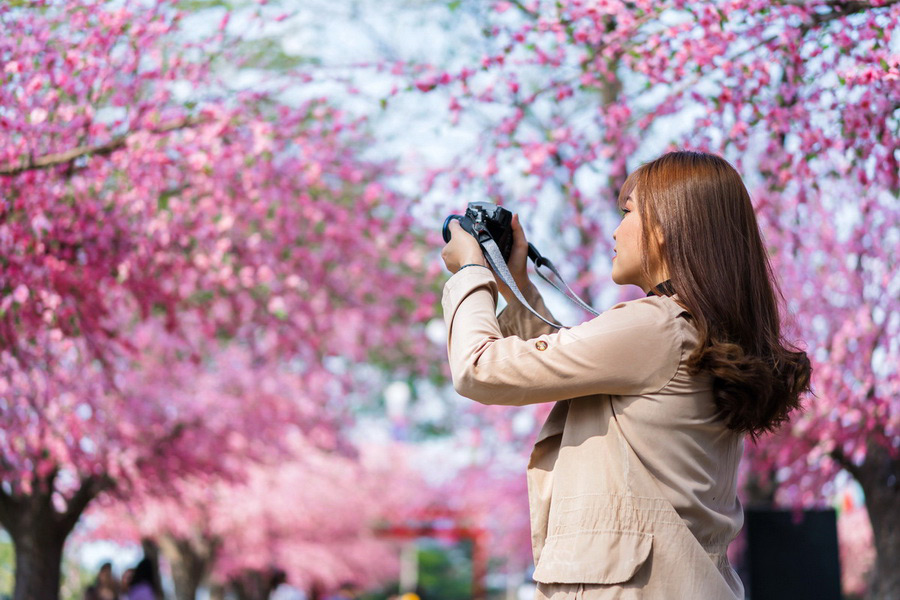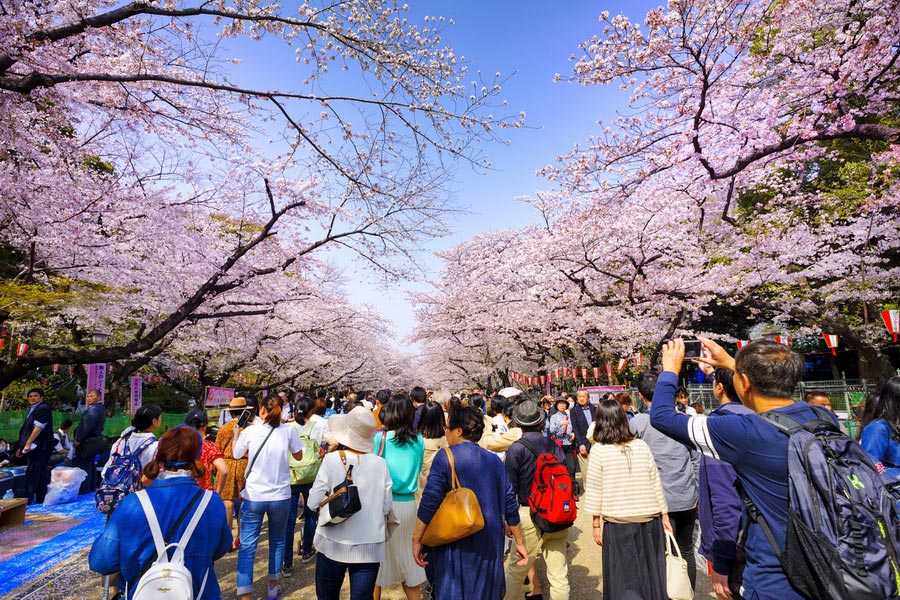
Hanami, also known as flower viewing, is a cherished Japanese traditional custom dedicated to admiring the blooms of plum (ume) and cherry (sakura) trees. Every spring, millions of people, including both locals and tourists, gather to stroll through the streets adorned with flower petals, soaking in the enchanting beauty of the season.
The cherry blossom season's timing varies by region and is announced in the news. In the southernmost region of Okinawa, trees start to bloom in late January. While Tokyo has cherry blossoms blooming in late March, on the islands of Kyushu and Shikoku, they are seen in early April. By early May, the blossoms reach the northernmost island of Hokkaido.
History of Hanami
The practice of flower viewing began during the Nara period (710-794). The initial focus was on plum blossoms due to the influence of Chinese culture, as plums were among the first trees imported from China. Over time, as Japan developed its own cultural identity, sakura trees became the central symbol of Hanami.
Until the Kamakura period (1185-1333), the celebration of cherry blossoms was mainly reserved for the imperial family and aristocrats, who would hold poetic gatherings and lavish picnics beneath the blooming trees. By the time of the Edo period (1603-1868), Hanami had become a popular festival that could be enjoyed by anyone, with sakura trees planted in city streets for public enjoyment.
How Hanami is Celebrated
Today, Hanami continues the age-old tradition with picnics under the blooming trees. People gather in parks and gardens, bringing food and drinks to enjoy while admiring the pink and white flowers. Festivals and fairs are also held, featuring traditional street food, souvenirs, and various entertainment activities. Besides sakura, other flowers such as tulips, sunflowers, and chrysanthemums are also celebrated, with their blooming schedules often announced in magazines and on the radio.
Preparing for Hanami
In order to fully enjoy Hanami, choose a day with pleasant weather and confirm the specific rules of the park you plan to visit, as they can vary. Picnic food is often either prepared in advance or bought at nearby fairs, with bento boxes—beautifully arranged meals featuring rice, fish, meat, vegetables, and fruits—being a popular choice. Traditional drinks include tea or sake, but other beverages like plum wine, beer, or shōchū (a drink distilled from rice, sweet potatoes, and rye) are also enjoyed, albeit in moderation to respect the atmosphere.
For a great spot in the park, it is best to arrive early and reserve your space with a blanket (burushito). Given the cool weather in early spring, a warm blanket can also be quite handy.
When and Where to Experience Hanami for Tourists

To experience the peak of Hanami, plan to visit Japan between late March and early April. Timing can vary by region:
- Tokyo and Kyoto: Late March to early April
- Osaka and Nara: Early April
- Hokkaido: Late April to early May
By planning around these dates, you can witness the cherry blossoms at their most vibrant.
Every city in Japan has parks where you can enjoy the cherry blossoms, but some stand out as particularly special.
Ueno Park - Tokyo
Ueno Park is one of Tokyo's most famous and oldest parks, steeped in rich history. Its wide avenues come alive with crowds of people eager to see the spectacular bloom of nearly 1,000 cherry trees, some of which surprise visitors by blooming earlier than expected.
Japanese National Imperial Garden of Shinjuku Gyoen - Tokyo
Shinjuku Gyoen boasts around 1,500 cherry trees from 75 different species, set around serene park ponds. Each year, the Hanami Festival, organized by the Prime Minister, attracts politicians, athletes, and artists. The park is open to everyone throughout the season, offering a calm setting for leisurely strolls amidst family-friendly surroundings.
Osaka Castle Park - Osaka

Osaka Castle is a popular destination, surrounded by a park filled with over 4,000 cherry trees. A breathtaking view is generated by the delicate blossoms' contrast with the majestic castle in the background. Both locals and tourists flock to Osaka Castle Park to enjoy the natural beauty.
Kiyomizu-dera Temple - Kyoto
Kiyomizu-dera is one of Kyoto's most renowned temples, surrounded by a multitude of cherry trees. For a breathtaking view of both the blossoms and the city of Kyoto, visitors can climb up to the temple’s veranda, which extends over the hillside pathway. The temple has a genuinely magical ambiance in the evening, thanks to its exquisite lighting.
Matsumae Park - Hokkaido
Matsumae Park is home to over 10,000 cherry trees, representing 250 species that bloom at different times, allowing visitors to experience the Hanami season later, in April and May. In addition to the stunning cherry blossoms, the park has nearby attractions like ancient temples.
Hanami Etiquette
- Take good care of the trees; breaking branches is strictly prohibited. Instead, consider buying souvenirs from local fairs.
- Keep things tidy. Since trash bins can be scarce in many parks, it’s a good idea to bring a garbage bag and carry out all your trash.
- Be mindful of the personal space of other visitors and conduct yourself modestly to ensure everyone’s comfort.
The Hanami Festival offers a unique opportunity to immerse yourself in Japanese culture, appreciate the natural beauty, and feel a deep connection with nature. No matter where you choose to celebrate in Japan, the memories of Hanami will last a lifetime.


